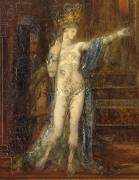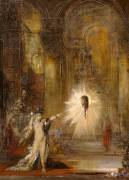Shop art print and framed art Christ of St. John of the Cross by Salvador Dali
Customise
Your art print
Christ of St. John of the Cross OF Salvador Dali
Christ of St. John of the Cross
The Christ of Saint John of the Cross: a mystical work by Salvador Dalí
Oil on canvas painted by Salvador Dalí in 1951 the origin of Christ of Saint John of the Cross is twofold: on the one hand, Salvador Dalí was inspired by a 16th-century drawing by the Spanish mystic Saint John of the Cross, depicting Christ on the Cross seen from above, and on the other, the Catalan painter claims to have had a dream of a triangle containing a circle, an image he associates with the drawing of the monastery and the structure of the atom, and which he incorporates into his composition.
This painting is part of a pivotal period in Dalí's life, marked by a return to the Catholic religion and a growing interest in science, particularly nuclear physics. The post-war context, with the horror of the atomic bomb and the emergence of the Cold War, also imbued the work with a spiritual and existential dimension. Dalí seeks to reconcile faith and science, through a representation of Christ that transcends traditional realism and embraces a cosmic vision of spirituality.
The Christ of Saint John of the Cross: a striking composition
The 205 cm by 116 cm work is striking for its bold composition and almost photographic realism. Christ, depicted crucified, seen from an unusual angle, plunging down, as if the viewer were contemplating him from heaven, plunges the viewer's gaze down on a peaceful landscape of bay and boats, contrasting with the drama of the crucifixion.
The muscular, athletic body of Christ is painted with an almost classical attention to anatomical detail. He hangs from a massive cross that stands out against a twilight sky of bluish and golden hues, tending towards black at the top of the canvas. The absence of nails, crown of thorns and blood contributes to an atmosphere of serenity and transcendence, far removed from classical representations of Christ.
Light plays a key role in the composition. It comes from an invisible source above Christ, illuminating his body and casting a shadow over the cross. This divine light lends Christ a supernatural aura and reinforces the mystical aspect of the scene.
Christ humanized and divinized in The Christ of Saint John of the Cross
Dalí depicts a Christ appearing young and muscular, whose face is hidden by the position of his drooping head. The absence of Christ's face and elements of suffering invites a more spiritual contemplation, detached from the physical aspects of suffering. The divine light that bathes Christ reinforces his sacred character and transcendent dimension. The overall composition, with its harmony and serenity, suggests an optimistic vision of faith, where suffering is sublimated by love and hope.
The artist moves away from traditional representations of the suffering Christ to propose an image of peace and redemption. The landscape below, with the bay of Portlligat, Dalí's place of residence, anchors the scene in reality and suggests that the divine is embodied in the earthly world, while Christ's perfect body, suspended above the world, evokes, through its beauty, a divine and transcendent dimension.
The artist moves away from traditional representations of the suffering Christ to propose an image of peace and redemption.
Impact and posterity of the Christ of Saint John of the Cross
The Christ of Saint John of the Cross is considered one of Dalí's major mature works. It marks a turning point in his career, confirming his return to the Catholic faith and his desire to concile art and spirituality. The painting was acquired by Glasgow's Kelvingrove Museum, and quickly became one of the most popular pieces in the collection.
Beyond its appeal as a work of art, Dalí was also one of the most important works in the collection.
Beyond its artistic value, The Christ of Saint John of the Cross has had a significant cultural impact. It has prompted numerous interpretations and analyses, contributing to Dalí's international renown, and inspired many audiences with its symbolic power and message of hope, transcending the boundaries of art and religion to reach a universal audience.
This artwork is a painting from the modern period. It belongs to the surrealism style.



































